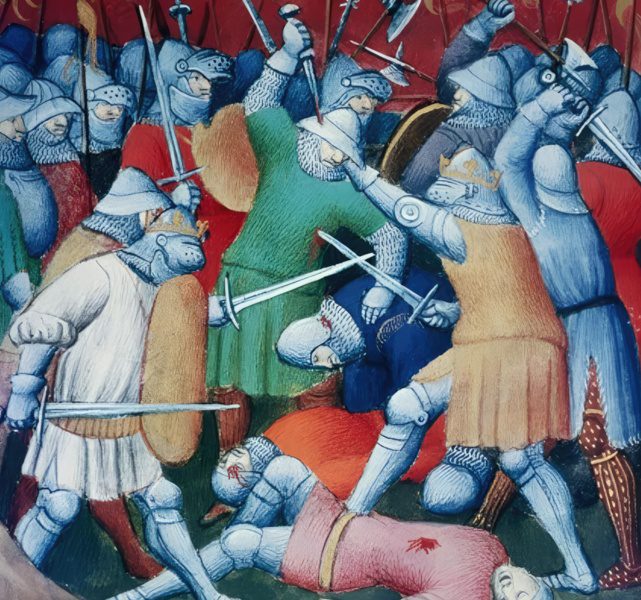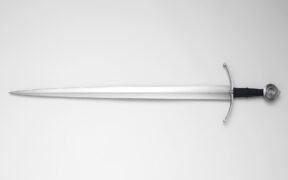Oakeshott Type XV: The First Medieval European Thrusting Sword
NO AI USED This Article has been written and edited by our team with no help of the AI

The Oakeshott type XV sword is the sixth double-edged blade group in Oakeshott’s Typology and the first sword made to hold up against plate armor. It was a sought-after European sword that would be used for over three centuries (13th-16th). Its blade characteristics were standard for almost all future one or two-handed swords focusing on thrusting capabilities.
Ewart Oakeshott was an English historian and illustrator who did profound research on European medieval arms and armor. He was a passionate sword enthusiast with his own collection of blades. His research was crucial in developing a double-edged European blade recognition system called Oakeshott’s Typology.
This article will explore the world of type XV swords, starting with their characteristics as beautiful as deadly. It will be explained how type XV traits were used on the battlefield, along with its sub-type that proved to be an even more popular weapon. We will conclude by touching upon its history and some historical antique examples.
Characteristics of Type XV Swords

The characteristics of Oakeshott type XV swords are some of the most interesting of all the previous types, crudely resembling those manufactured in the Early Middle Ages. They could be sophisticated in design due to their crossguard forms and thin, tapering blades with a mid-rib through their center, making them stand out from many other contemporary sword designs.
But the characteristics of Type XV swords weren’t for aesthetics alone. They were practical and would set a new standard for European double-edged swords with similar traits.
Blade

The blade of the type XV sword was much different than all the previous Oakeshott types. It had a straight, double-edged blade, was slim in design, and tapered to a sharp point. The blade’s tip is a flattened diamond cross-section, which enhances its thrusting capabilities. The blade profile is broad near the hilt, with a diamond cross-section or a hollow ground section running throughout its entire length.
Type XV blades didn’t have fullers like the previous double-edged European swords. Instead, they had a reinforced mid-rib that ran from the crossguard through the tip. The tang underneath the handle was narrow toward the pommel with a profiled rectangular cross-section. Manufactured XV blades were extremely stiff and pointed, making them sturdy thrusting weapons.
Hilt (Guard and Pommel)

The parent Oakeshott type XV sword’s one-handed hilt and handle made it a direct fit for the hand regardless of gloved armor. The crossguard was narrowed to the blade while remaining fairly slim as it widened to the left and right. The quillons, terminals, and ending tips were turned and bent toward the blade. Type XV crossguards could be more sophisticated and have a pronounced protrusion at the center.
The pommels could vary in shape but were primarily rounded or disc-shaped, similar to the previous type XIV. Some pommels were cultivated with chamfered edges. They were larger, acting as an effective hand backstop point and balancing the weight to allow the sword to be successfully guided with its pointed tip toward gaps in the enemy’s armor.
Size and Weight

Type XV swords are generally one-handed weapons used for precise thrusts or cuts. They are smaller and typically weigh around two to three lbs (0.9 to 1.3 kg), but some swords could have been heavier, depending on their proportions.
Being a one-handed sword designed for deliberate thrust attacks made the XV a shorter weapon. The usual blade length for the type XV was 29 to 33 inches (74 to 84 cm). Their handles could be larger than a typical one-handed size, around four to 5.9 inches (10 to 15 cm), making the overall sword length for type X around 36 inches (91 cm).
Sub-Type XVa

While researching type XV swords, Oakeshott discovered many blade designs with the same profile and handle characteristics but with more sizable dimensions. He categorized these larger tapering-bladed swords as a sub-type XVa. These swords could have the same or larger blades, while their hilts were consistently longer, reaching nine inches (23 cm) at times.
Type XVa are the first true bastard swords used with hand-and-a-half or two hands. This made them effective for not only battling plate armor but also possessing great power in the thrust when finishing a downed opponent.
These combat characteristics made the Oakeshott sub-type XVa bastard sword more desirable than its parent type. Some sub-types had a more slender blade profile, further enhancing their thrusting power.
Uses for the Type XV Swords

Oakeshott type XV swords were completely different weapons of war than previous types. While existing types experimented with cutting and thrusting with an accent on cutting, the type XV was entirely focused on delivering deadly stabs and thrusts. While it could be effective for cutting, its stiff blade reinforced by a midrib made it the ideal thrusting weapon of war.
It could be held with one hand, while its sub-type could be used with a hand and a half or as a two-handed weapon. Its weight made it an easy weapon to balance and navigate its tip through gaps in the enemy’s plate armor. Its tapering blade could also be half-sworded or held with two hands and navigated like a dagger through weak points of the armor.
This Oakeshott type started developing a distinctive and versatile sword that could be used without a shield by an armored knight. It could also act as a primary weapon in certain combat situations, such as lancing while charging on horseback.
History and Historical Examples of Type XV Swords

Oakeshott classified and grouped the European double-edged swords of his typology into two primary groups. Group one were swords created to combat chainmail armor, while group two were blades made to hold up against new and improved plate armor. Type XV swords were the first Oakeshott blades to deal with early and late plate armor worn over chainmail and gambesons.

These Oakeshott types are sometimes called bastard or hand-and-a-half swords due to their larger design. Because of their popularity, their use spanned over three centuries, from the late 13th through the 16th century. Some historians trace the type XV sword to the rise of improved chainmail armor during the 13th century.

The race to improve armor was compromised by the type XV. Though plate armor was the ultimate victor, the slender blade design of the thrusting XV also frequented the battlefields of Germany, England, Spain, Italy, and France, such as the Battle of Castillon (1453), which was the last in a series of battles in The Hundred Years’ War (1337-1453). Thanks to its effectiveness, it would set a new norm and was followed by all other European swords to come.

This sword type also has plenty of surviving examples, allowing scholars to study it thoroughly. The type XV and its sub-type XVa are frequently seen in literature and 15th-century Italian art, such as The Victory of Heraclius Over Chosroes by Piero della Francesca. The sword is also found in over 80% of tomb effigies of knights of its time and some fencing manuals, such as the Bauman Fechtbuch from the 15th century.

Both swords were highly specialized weapons that were devastatingly successful in battle, modern-day HEMA (historical European martial arts), and cutting practice tests.





